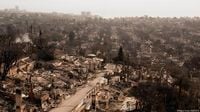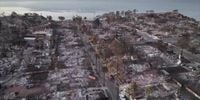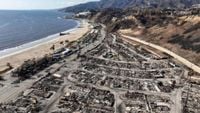When the Palisades Fire erupted in Los Angeles on January 7, 2025, few could have predicted the scope of destruction it would unleash. Over the following 25 days, relentless flames tore through the Pacific Palisades and Malibu, reducing more than 6,800 structures to ash, consuming over 23,000 acres, and claiming 12 lives. Now, after months of speculation and anguish, federal investigators have arrested Jonathan Rinderknecht, a 29-year-old former Palisades resident and Florida transplant, alleging that he set in motion the chain of events that led to one of the most devastating wildfires in California’s history.
According to CBS12, Rinderknecht was working as an Uber driver in California on New Year’s Eve. Passengers he ferried that night later told investigators he appeared angry and agitated. After dropping them off, authorities say, he drove into the Santa Monica Mountains National Recreation Area and set what became known as the Lachman Fire, using an open flame shortly after midnight on January 1, 2025. The Bureau of Alcohol, Tobacco, Firearms and Explosives (ATF) ruled out other potential causes such as fireworks, lightning, power lines, or even a discarded cigarette. Acting U.S. Attorney Bill Essayli stated, “As the world watched in horror as the Palisades Fire burned, victims perished in the smoke and flames.”
Firefighters from the Los Angeles Fire Department (LAFD) and Los Angeles County Fire Department responded quickly, using water drops from aircraft and deploying handlines to battle the initial blaze. By the morning of January 2, they believed they had fully extinguished the fire and collected their hoses. But unbeknownst to anyone, as detailed in the federal complaint, the fire continued to smolder underground within the roots of dense vegetation.
Six days later, on January 7, fierce and unprecedented winds swept through the region. The dormant embers reignited with a vengeance, transforming the small, seemingly contained Lachman Fire into the inferno now known as the Palisades Fire. Special agent Kenny Cooper of the ATF, who led the nine-month investigation, described the blaze as a “holdover” fire—a direct continuation of the earlier incident.
For survivors and local officials, the arrest both affirmed long-held suspicions and reopened fresh wounds. Allison Polhill, a senior advisor for LAUSD Board Member Nick Melvoin and a Palisades resident, recalled, “We were all like, nine months later, come on, everybody knows. It was the exact same. This guy set a fire on Jan. 1… Everybody knew—there were predictions of dangerous high winds.” Polhill helped evacuate children as the fire spread, and her own New Year’s Eve was interrupted by the sight of flames from her home. “It re-opens a wound after nine months,” she admitted to Los Angeles Daily News.
Blake Armstrong, whose home at Tahitian Terrace mobile park was among the first to burn, expressed skepticism about the connection between the two fires, saying, “The nexus between the fact he started a fire on Jan. 1 and it was reignited seems attenuated to me as to his intent, but I look forward to seeing what the evidence is.”
Others, like fire survivor Denise Doyen, placed the blame squarely on the suspect, not the firefighters. “They were doing a great job, but it was impossible odds once the winds were that bad and the airplanes were grounded,” Doyen said. “And how long do you babysit a fire? Those winds were unbelievable.” She described the scene as a “freak thing,” recalling how the winds in her home were so strong they knocked over an 80-pound ping pong table.
The arrest of Rinderknecht was announced by California Governor Gavin Newsom on October 9, 2025. In a statement reported by CBS12 and Los Angeles Daily News, Newsom said, “Today’s arrest of 29-year-old Florida resident Jonathan Rinderknecht marks an important step toward uncovering how the horrific Palisades Fire began and bringing closure to the thousands of Californians whose lives were upended. This tragedy will never be forgotten—lives were lost, families torn apart, and entire communities forever changed—and there must be accountability.”
Federal prosecutors charged Rinderknecht with destruction of property by means of fire, a felony that carries a minimum five-year prison sentence and up to 20 years if convicted. The criminal complaint details how Rinderknecht not only started the fire but also later returned to the scene to film firefighters battling the flames. Investigators noted that months before the fire, he used ChatGPT to create a “dystopian” digital image of a burning forest with crowds fleeing—an unsettling foreshadowing of the real-life tragedy to come.
Neighbors in Melbourne, Florida, where Rinderknecht was arrested, were stunned by the news. “This is a close-knit community and we’ve never seen him,” said David Peters, a resident connected to one of Rinderknecht’s local addresses. “To do such a heinous crime and just go about it like your daily business like nothing happened—I don’t know, it’s crazy.” Chrystal Rodriguez, another neighbor, expressed her sorrow: “I am sad. I am sad. For all the family members lost that could’ve been their mother, father, daughter, son, grandchild—one life lost is way too many.”
The Palisades Fire’s impact extended far beyond the immediate loss of life and property. Families were displaced, entire neighborhoods were erased, and the emotional toll continues to reverberate. Los Angeles Mayor Karen Bass praised the multi-agency investigation and said the arrest is “one step forward in bringing displaced Angelenos home while working toward closure and towards justice.” Supervisor Lindsey Horvath echoed this sentiment, stating that while the arrest cannot erase the pain and loss, “it is a step toward accountability.”
The LAFD’s after-action report, released in the wake of the arrest, highlighted the extraordinary challenges responders faced: staffing shortages, communication breakdowns, and the sheer force of the winds. Interim LAFD Chief Ronnie Villanueva told City News Service that key takeaways include the need for leadership changes, stronger recall protocols, and improved public notification systems. The department’s report also noted the importance of interagency collaboration—a lesson burned into the city’s collective memory by the Palisades Fire.
Meanwhile, the Palisades Fire investigation has been contrasted with that of the Eaton Fire, which broke out the same day in Altadena and killed 19 people. Joy Chen, executive director of the Eaton Fire Survivors Network, pointed out that while the Palisades Fire now has a confirmed cause and suspect, the Eaton Fire remains officially undetermined, with lingering questions about resource allocation and emergency alerts.
For many, the arrest of Jonathan Rinderknecht represents a critical step toward justice and closure, but it cannot undo the devastation wrought by the fire. As the legal process unfolds, survivors and the broader Los Angeles community continue to rebuild—physically and emotionally—hoping that lessons learned will help prevent future tragedies of this magnitude.



